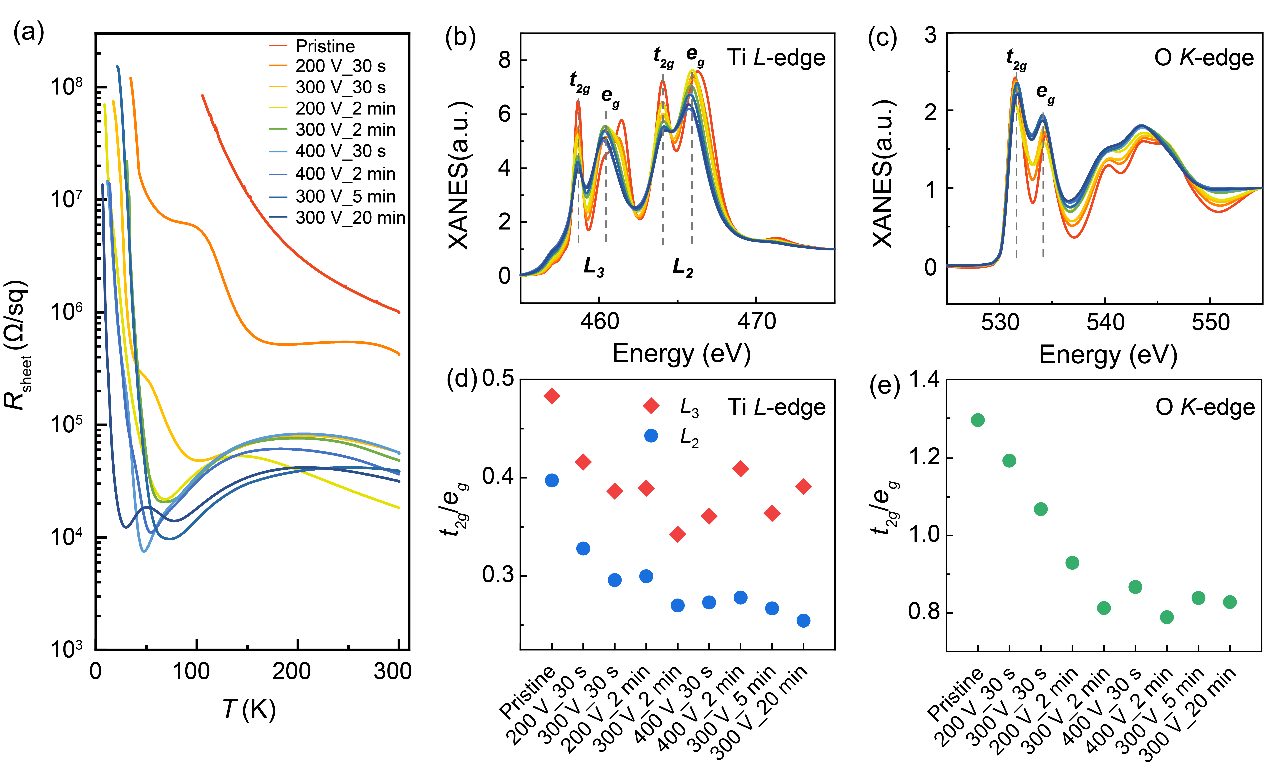Scientific Achievement
Professor Yu Pu's group at the Department of Physics, Tsinghua University, in collaboration with the Soft X-ray Spectromicroscopy Beamline (BL08U1A)of the Shanghai Synchrotron Radiation Facility, has probed the two-dimensional electron gas on the surface of TiO2 material using XAS, in-situ electric transport, and electron microscopy, revealing the correlation/coupling properties between localized electrons and high mobility electrons.
Significance and Impact
This study enriches the understanding of the formation and transport mechanism of two-dimensional electron gas, and provides a new idea to probe the exotic electronic states on complex oxide surfaces. The results, titled "Coexistence of Both Localized Electronic States and Electron Gas at Rutile TiO2 Surfaces," were published on June 11, 2023, in Advanced Materials.
Research background
Oxide surfaces and interfacial systems present a rich variety of presentation phenomena, such as LaAlO3/SrTiO3 interface with high mobility two-dimensional electron gas, superconductivity, magnetism, etc., is a platform to study the exotic electronic and magnetic states in the low-dimensional system of complex oxides. These rich physical properties and the carriers and their coupling to the lattice of the material system are closely related to each other. Revealing their effects on physical properties and derived functions is of great significance for both scientific research and potential applications. The coupling of carriers to localized lattice distortions results in the formation of charge-localized polaritons, which have a significant impact on many physical properties of materials, such as superconductivity, giant magnetoresistance, thermoelectricity, surface chemistry, and so on. Depending on the degree of carrier localization, localized polaritons are usually classified into two categories: large polaritons and small polaritons. Large polarizers usually have a few cell scales, their local energy levels are roughly around 10 meV near the Fermi surface, they exhibit quasiparticle behavior close to free migration, and the system is electrically conductive metallic. While small polarizers are generally smaller (single cell size), their local energy levels are also higher (1 eV near the Fermi surface), and the system is usually insulating. In recent years, it has been found that some material systems can exhibit both high mobility carrier transport and localized small polariton behavior; however, the coexistence mechanism and transition modulation between the two need to be further investigated.
Main research contents
Rutile TiO2 is a typical material with polariton transport behavior. Experimental and theoretical studies have shown that the presence of small polaritons and oxygen vacancies can induce two-dimensional electron gas on the surface of rutile TiO2, which provides a potential research vehicle to explore the correlation between high mobility carrier transport and localized small polariton behavior. The research group introduced a high concentration of oxygen defects on the surface of rutile TiO2 by vacuum argon ion bombardment, which led to the partial filling of the 3d1 energy level of Ti ions, and then observed quasi-two-dimensional electron gas properties (XAS spectra). Unlike the widely studied 2D electron gas system at the SrTiO3 surface interface, it is found that the carrier concentration in the electron gas on the TiO2 surface decreases drastically with decreasing temperature, resulting in a significant metal-insulator transition; however, the electron mobility in the insulating state is still as high as ~103 cm2V-1s-1. This is attributed to the fact that the electron mobility in the rutile TiO2 surface at lower temperatures is still high than that in the insulating state, and the electron mobility in the insulating state is still as high as ~103 cm2V-1s-1. This is due to the fact that at lower temperatures the doped electrons in the rutile TiO2 lattice form localized electronic states at shallow energy levels and gradually freeze at these localized energy levels as the temperature decreases. They further achieved continuous electron doping modulation in this system by means of in situ ionic liquid gate circuit modulation, resulting in a systematic enhancement of the high-temperature conductivity of the system; however, interestingly, the behavior of the system's low-temperature localized electronic state does not change with electron doping, a result that suggests that the low-temperature localized state is the intrinsic physical property of the material. In addition, they found that the use of a longitudinal electrostatic field can control the transformation of localized electrons into free-electron behavior, which leads to the system exhibiting an electric-field controllable insulator-metal phase transition; furthermore, negative differential resistance behavior due to reduced carrier mobility is observed at high fields.

Fig. 1. R(T) curves and XANES spectra (TEY mode at Ti L-edge and O K-edge) of TiO2 surfaces under different argon ion bombardment conditions。
Bright Future Prospects
This study reveals the important influence of carriers and their coupling to the lattice in the oxide surface interface system on the physical properties and derived functions of the materials, which provides a new idea for probing the exotic electronic states on the surface of complex oxides and sheds light on the future scientific research and potential applications of the low-dimensional system。
Contact:
BL08U1A user coordinator:Zijian Xu,xuzj@sari.ac.cn, 13681612583
Publication
Shengchun Shen,* Meng Wang, Yang Zhang, Yingjie Lyu, Di Tian, Chang Gao,
Youwen Long, Jin Zhao, and Pu Yu,* Coexistence of Both Localized Electronic States and Electron Gas at Rutile TiO2 Surfaces. Advanced Materials 35, 2301453 (2023).
附件下载:
